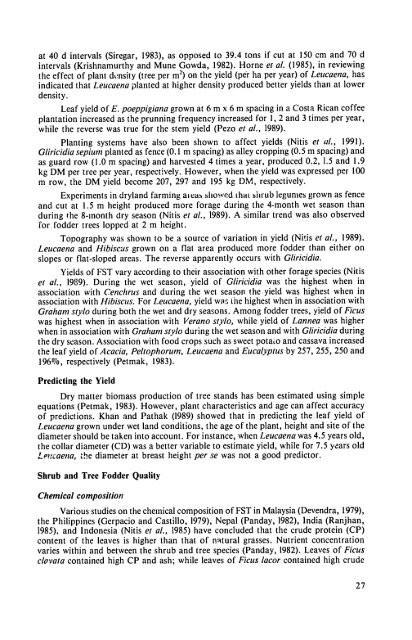Proceedings of a workshop on research methodologies Medan ...
Proceedings of a workshop on research methodologies Medan ...
Proceedings of a workshop on research methodologies Medan ...
You also want an ePaper? Increase the reach of your titles
YUMPU automatically turns print PDFs into web optimized ePapers that Google loves.
at 40 d intervals (Siregar, 1983), as opposed to 39.4 t<strong>on</strong>s if cut at 150 cm and 70 d<br />
intervals (Krishnamurthy and Mune Gowda, 1982). Horne et al. (1985), in reviewing<br />
the effect <str<strong>on</strong>g>of</str<strong>on</strong>g> plant density (tree per M 2 ) <strong>on</strong> the yield (per ha per year) <str<strong>on</strong>g>of</str<strong>on</strong>g> Leucaena, has<br />
indicated that Leucaena planted at higher density produced better yields than at lower<br />
density.<br />
Leaf yield <str<strong>on</strong>g>of</str<strong>on</strong>g> E. poeppigianagrown at 6 m x 6 m spacing in a Costa Rican c<str<strong>on</strong>g>of</str<strong>on</strong>g>fee<br />
plantati<strong>on</strong> increased as the prunning frequency increased for 1, 2 and 3 times per year,<br />
while the reverse was true for the stem yield (Pezo et al., 1989).<br />
Planting systems have also been shown to affect yields (Nitis et a/., 1991).<br />
Gliricidiasepiumplanted as fence (0. 1 m spacing) as alley cropping (0.5 m spacing) and<br />
as guard row (1.0 m spacing) and harvested 4 times a year, produced 0.2, 1.5 and 1.9<br />
kg DM per tree per year, respectively. However, when the yield was expressed per 100<br />
m row, the DM yield become 207, 297 and 195 kg DM, respectively.<br />
Experiments in dryland farming aieas showed that :ihrub legumes grown as fence<br />
and cut at 1.5 m height produced more forage during the 4-m<strong>on</strong>th wet seas<strong>on</strong> than<br />
during the 8-m<strong>on</strong>th dry seas<strong>on</strong> (Nitis et al., 1989). A similar trend was also observed<br />
for fodder trees lopped at 2 m height.<br />
Topography was shown to be a source <str<strong>on</strong>g>of</str<strong>on</strong>g> variati<strong>on</strong> in yield (Nitis et al., 1989).<br />
Leucaena and Hibiscus grown <strong>on</strong> a flat area produced more fodder than either <strong>on</strong><br />
slopes or flat-sloped areas. The reverse apparently occurs with Gliricidia.<br />
Yields <str<strong>on</strong>g>of</str<strong>on</strong>g> FST vary according to their associati<strong>on</strong> with other forage species (Nitis<br />
et al., 1989). During the wet seas<strong>on</strong>, yield <str<strong>on</strong>g>of</str<strong>on</strong>g> Gliricidia was the highest when in<br />
associati<strong>on</strong> with Cenchrus and during the wet seas<strong>on</strong> the yield was highest when in<br />
associati<strong>on</strong> with Hibiscus. For Leucaena, yield was the highest when in associati<strong>on</strong> with<br />
Grahamstylo during both the wet and dry seas<strong>on</strong>s. Am<strong>on</strong>g fodder trees, yield <str<strong>on</strong>g>of</str<strong>on</strong>g> Ficus<br />
was highest when in associati<strong>on</strong> with Verano stylo, while yield <str<strong>on</strong>g>of</str<strong>on</strong>g> Lannea was higher<br />
when in associati<strong>on</strong> with Grahamstylo during the wet seas<strong>on</strong> and with Gliricidiaduring<br />
the dry seas<strong>on</strong>. Associati<strong>on</strong> with food crops such as sweet potato and cassava increased<br />
the leaf yield <str<strong>on</strong>g>of</str<strong>on</strong>g> Acacia, Peltophorum, Leucaena and Eucalyptus by 257, 255, 250 and<br />
196%, respectively (Petmak, 1983).<br />
Predicting the Yield<br />
Dry matter biomass producti<strong>on</strong> <str<strong>on</strong>g>of</str<strong>on</strong>g> tree stands has been estimated using simple<br />
equati<strong>on</strong>s (Petmak, 1983). However, plant characteristics and age can affect accuracy<br />
<str<strong>on</strong>g>of</str<strong>on</strong>g> predicti<strong>on</strong>s. Khan and Pathak (1989) showed that in predicting the leaf yield <str<strong>on</strong>g>of</str<strong>on</strong>g><br />
Leucaenagrown under wet land c<strong>on</strong>diti<strong>on</strong>s, the age <str<strong>on</strong>g>of</str<strong>on</strong>g> the plant, height and site <str<strong>on</strong>g>of</str<strong>on</strong>g> the<br />
diameter should be taken into account. For instance, when Leucaena was 4.5 years old,<br />
the collar diameter (CD) was a better variable to estimate yield, while for 7.5 years old<br />
I ::caena, the diameter at breast height per se was not a good predictor.<br />
Shrub and Tree Fodder Quality<br />
Chemical compositi<strong>on</strong><br />
Various studies <strong>on</strong> the chemical compositi<strong>on</strong> <str<strong>on</strong>g>of</str<strong>on</strong>g> FST in Malaysia (Devendra, 1979),<br />
the Philippines (Gerpacio and Castillo, 1979), Nepal (Panday, 1982), India (Ranjhan,<br />
1985), and Ind<strong>on</strong>esia (Nitis et al., 1985) have c<strong>on</strong>cluded that the crude protein (CP)<br />
c<strong>on</strong>tent <str<strong>on</strong>g>of</str<strong>on</strong>g> the leaves is higher than that <str<strong>on</strong>g>of</str<strong>on</strong>g> natural grasses. Nutrient c<strong>on</strong>centrati<strong>on</strong><br />
varies within and between the shrub and tree species (Panday, 1982). Leaves <str<strong>on</strong>g>of</str<strong>on</strong>g> Ficus<br />
clavata c<strong>on</strong>tained high CP and ash; while leaves <str<strong>on</strong>g>of</str<strong>on</strong>g> Ficus lacor c<strong>on</strong>tained high crude<br />
27

















